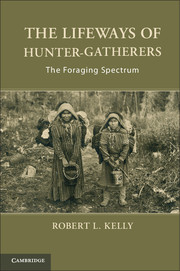Book contents
- Frontmatter
- Contents
- Tables
- Figures
- Preface
- Acknowledgments
- One Hunter-Gatherers and Anthropology
- Two Environment, Evolution, and Anthropological Theory
- Three Foraging and Subsistence
- Four Mobility
- Five Technology
- Six Sharing, Exchange, and Land Tenure
- Seven Group Size and Demography
- Eight Men, Women, and Foraging
- Nine Nonegalitarian Hunter-Gatherers
- Ten Hunter-Gatherers and Prehistory
- Notes
- References
- Index
Four - Mobility
Published online by Cambridge University Press: 05 April 2013
- Frontmatter
- Contents
- Tables
- Figures
- Preface
- Acknowledgments
- One Hunter-Gatherers and Anthropology
- Two Environment, Evolution, and Anthropological Theory
- Three Foraging and Subsistence
- Four Mobility
- Five Technology
- Six Sharing, Exchange, and Land Tenure
- Seven Group Size and Demography
- Eight Men, Women, and Foraging
- Nine Nonegalitarian Hunter-Gatherers
- Ten Hunter-Gatherers and Prehistory
- Notes
- References
- Index
Summary
When I’m a kid we're always moving. Never stay around one place for long. We got to move, otherwise we find no food. Even then sometimes there's no food for a while, so people in camps go hungry. Wherever there's food, well, we got to move to that place.
Kutchin man (Nelson 1986: 273)[We do not like] sitting one place all the time like white men.
Kaska man (Honigmann 1949: 102)There is hardly a more romantic image in anthropology than that of a small band of hunter-gatherers setting off through the dunes and scrub, their few belongings slung over their shoulders – people who are attached to all places but none too strongly. This image is one of the first that students associate with hunter-gatherers, and it is significant for professionals as well. At Man the Hunter, Lee and DeVore (1968: 11) defined hunter-gatherers as people who “move around a lot” and whose lives are strongly determined by this fact. And they were right; mobility does indeed exert a strong influence over other elements of foragers’ lives. Marcel Mauss, for example, linked the Eskimos’ moral and religious life to their seasonal mobility (Mauss 1904–05), and Sahlins (1972) saw mobility as conditioning hunter-gatherers’ laissez-faire attitude toward material goods.
In the 1970s, archaeologists became interested in the seasonal rounds of hunter-gatherers, those movements that foragers make from one place to another as resources come and go with the seasons (e.g., Thomas 1973; Bettinger 1977). The Great Basin Shoshone, for example, spent the winter in villages in the piñon and juniper forests of the mountains (Figure 4-1). As spring came, they moved down to the valley floors and gathered tubers, bulbs, and the first seeds of spring; later, they moved upslope as seeds ripened there. In the summer, they might move to a river where trout were running, or to a marsh where they could hunt waterfowl and gather bulrush seeds. In the early fall, they would move back into the mountains, establish winter camps, and collect piñon nuts while hunting deer and bighorn sheep.
- Type
- Chapter
- Information
- The Lifeways of Hunter-GatherersThe Foraging Spectrum, pp. 77 - 113Publisher: Cambridge University PressPrint publication year: 2013
- 2
- Cited by



